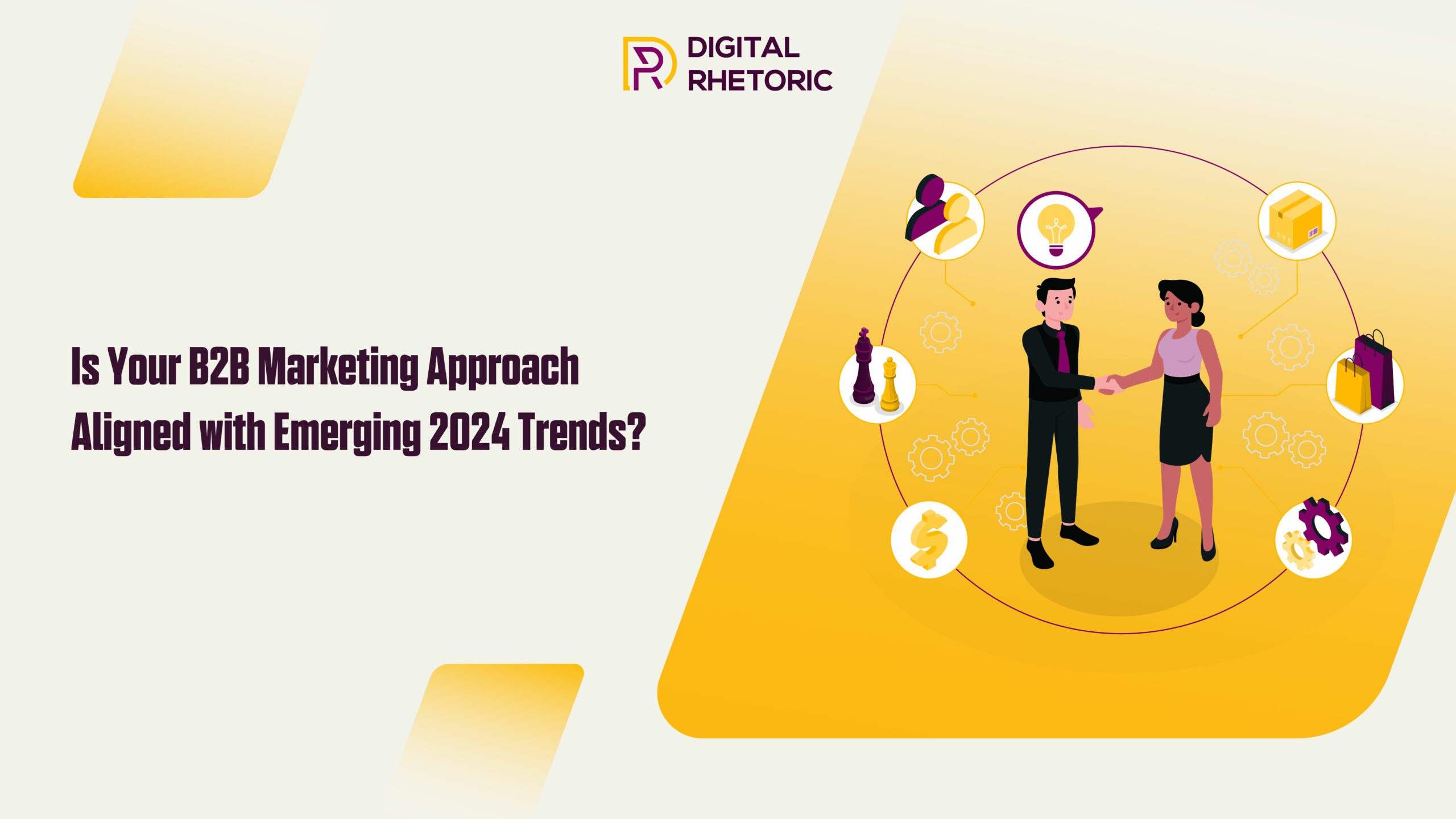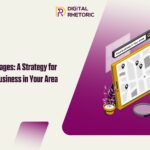Is Your B2B Marketing Approach Aligned with Emerging 2024 Trends?
- Meenal Ghai
- January 1, 2024
- Blog, Digital Marketing
- Digital Marketing Agency, Digital Marketing Company, Digital Marketing Services, PPC Marketing Services, Search Engine Optimization, SEO Services, Social Media Marketing
- 0 Comments

In 2024, the landscape of B2B marketing is evolving rapidly, influenced by a series of emerging trends that redefine how businesses engage with their clients. As we navigate this dynamic environment, it’s essential to examine whether your B2B marketing approach aligns with these new directions. Key trends include the rise of generative AI (GenAI) reshaping marketing activities, a shift towards enabling buyers to make more independent decisions, a move away from hyper-targeted strategies, and an increased emphasis on integrating advanced technologies like video marketing and virtual reality. Aligning with these trends is not just beneficial; it’s imperative for staying competitive and relevant in the ever-changing B2B market.
Independent Decision-Making Tools
In the rapidly evolving digital arena, B2B marketers are increasingly adopting a customer-centric approach, emphasizing the creation of content and tools that empower buyers to make informed decisions independently. This significant shift is marked by a move towards transparent pricing and the provision of personalized product demos that reduce or even eliminate the need for initial sales representative involvement. This transformation is not just a trend; it’s a response to the growing demand for autonomy and accessibility in the B2B purchasing journey.
The impact of this approach in the digital space is multi-dimensional. Firstly, it fosters a sense of trust and transparency between businesses and their clients. When pricing is clear and upfront, and product capabilities are showcased through interactive demos, it eliminates the opaqueness that often hinders the decision-making process. This transparency not only accelerates the purchasing cycle but also builds long-term trust, which is crucial in the B2B sector.
Moreover, by providing tools for self-guided exploration, companies cater to the modern buyer’s preference for self-service. This autonomy not only enhances customer satisfaction but also allows sales teams to focus on more value-added activities, such as addressing complex queries and closing deals, rather than spending time on preliminary product introductions.
Several well-known companies have already embraced this approach. For instance, HubSpot, a leader in inbound marketing and sales software, offers extensive online resources and tools that allow potential customers to understand and evaluate their offerings independently. Similarly, Salesforce provides a comprehensive suite of online demos and detailed product information, enabling businesses to explore their CRM solutions without immediate sales interaction. These examples underscore how self-service models are revolutionizing the B2B marketing landscape, aligning with the evolving preferences of digital-savvy customers and paving the way for more efficient and effective business interactions.
So, this strategic shift in B2B marketing not only aligns with the digital transformation but also significantly enhances the buyer experience, leading to more informed decisions, increased efficiency, and stronger business relationships.
Generative AI (GenAI)
In the B2B marketing realm, the advent of Generative AI (GenAI) is poised to revolutionize various marketing activities, bringing with it a set of challenges and opportunities:
- Data-Driven Personalization: GenAI enables hyper-personalization in marketing strategies. This can lead to highly tailored content and campaigns, resonating more effectively with targeted audiences.
- Content Creation: With GenAI, creating diverse content formats becomes more efficient, enhancing engagement across different platforms.
- Customer Insights: GenAI tools can analyze vast amounts of data, providing deeper insights into customer behavior and preferences.
- Automation of Routine Tasks: Routine marketing tasks like email marketing, social media posts, and data analysis can be automated, increasing efficiency.
However, with these advancements, certain challenges need addressing:
- Data Privacy and Security: As GenAI relies heavily on data, there’s an increased focus on ensuring data privacy and security.
- Brand Authenticity: Maintaining brand authenticity in AI-generated content is crucial to avoid a disconnect with the audience.
- Skill Gap: The need for skills to manage and interpret GenAI outputs is imperative.
Comparative Table of Positive and Negative Impacts of GenAI in B2B Marketing:
| ASPECT | POSITIVE IMPACT | NEGATIVE IMPACT |
| Efficiency | Streamlines marketing processes and reduces manual workload. | May lead to over-reliance on automation, reducing human touch. |
| Personalization | Enhances customer experience with highly personalized content. | Risks of data misuse and privacy concerns. |
| Content Quality | Enables high-quality, diverse content creation. | Potential loss of brand voice and authenticity. |
| Data Analysis | Provides deeper insights into customer behavior and preferences. | Requires advanced skills to interpret and utilize data properly. |
| Brand Reputation | Can improve engagement and customer loyalty when used effectively. | Mismanagement or ethical issues can harm brand reputation. |
In summary, while GenAI brings about efficiency and enhanced personalization in B2B marketing, it also necessitates a careful balance between leveraging technology and maintaining ethical standards, data security, and brand authenticity.
Moving Away from Hyper-Targeting
The shift away from hyper-targeting strategies such as Account-Based Marketing (ABM) in favor of a more balanced approach integrates broader marketing tactics. This evolution is driven by the need to reach a wider audience while maintaining the precision of targeting. Several strategies have emerged as part of this balanced approach:
- Content Marketing: Focusing on creating valuable, relevant content to attract a broader audience. This strategy helps in establishing thought leadership and brand authority.
- Inbound Marketing: Inbound tactics attract customers through content and interactions that are helpful and relevant, as opposed to interruptive outbound strategies.
- Omni-Channel Marketing: Engaging with prospects across various channels – online and offline – to create a seamless customer experience.
- Community Building: Fostering a community around a brand or industry, which can include forums, social media groups, or events, to engage a wider audience.
- Data-Driven Marketing: Utilizing data analytics not just for targeting specific accounts but for understanding broader market trends and customer segments.
Several global examples illustrate the positive impact of these strategies:
- IBM: IBM’s shift towards content marketing and thought leadership has been instrumental in reaching a wider audience. Their focus on providing industry insights and technology trends has helped establish them as a leader in the tech industry.
- Adobe: Adobe’s use of omni-channel marketing strategies, including social media, webinars, and events, has helped them engage with a diverse range of customers, from individual creatives to large enterprises.
- Salesforce: Salesforce has effectively used community building with its online community platform, Trailblazer Community, which not only serves as a support forum but also as a platform for engagement and learning, reaching a broader audience.
- HubSpot: Known for pioneering inbound marketing, HubSpot’s approach of attracting customers through valuable content, tools, and resources has been a game-changer in how businesses approach broader market engagement.
These examples highlight how a balanced approach, integrating targeted strategies with broader marketing tactics, can lead to more comprehensive engagement and sustainable business growth.
Embracing Technology and Eliminating Barriers
The embrace of technology in B2B marketing in 2024 is characterized by a variety of innovative tech solutions. These technologies aim to eliminate barriers and create more engaging, immersive marketing experiences. Below is a list of these new changes along with a brief description and real-life examples from renowned brands:
- Video Marketing: Leveraging video content for storytelling, product demos, and customer testimonials. Videos are effective in conveying complex information in an engaging way.
- Example: Cisco has utilized video marketing effectively, using videos to explain their complex networking solutions in an accessible manner.
- Virtual Reality (VR) and Augmented Reality (AR): Providing immersive experiences that allow customers to explore products or services in a simulated environment.
- Example: Autodesk, a leader in 3D design, engineering, and entertainment software, uses VR to showcase its products and give customers a hands-on experience without physical prototypes.
- Artificial Intelligence (AI) and Machine Learning (ML): Enhancing customer experiences through personalized recommendations, predictive analytics, and automated customer service.
- Example: Salesforce uses AI through its Einstein platform to provide personalized customer insights and predictive analytics to its B2B clients.
- Chatbots and Virtual Assistants: Automating customer service and lead qualification, providing instant responses to queries, and improving user engagement.
- Example: HubSpot offers chatbot solutions that enable businesses to automate and personalize customer interactions on their websites.
- Interactive Content: Using quizzes, polls, and interactive infographics to engage audiences more deeply and collect valuable data.
- Example: Buzzfeed, although more consumer-focused, has set a benchmark with interactive content, providing insights into how interactive elements can boost engagement.
- Data Analytics and Big Data: Utilizing large datasets to derive insights, tailor marketing strategies, and make data-driven decisions.
- Example: IBM’s Watson Analytics provides powerful data analysis, helping B2B marketers to gain insights and make informed decisions.
- Blockchain Technology: For enhancing security, transparency in transactions, and improving supply chain management.
- Example: IBM Blockchain has been used to improve transparency and efficiency in supply chains, demonstrating its potential in B2B contexts.
Each of these technological advancements offers unique benefits in enhancing marketing strategies, improving customer engagement, and driving business growth. By integrating these technologies, B2B marketers can create more dynamic, personalized, and effective marketing campaigns.
These trends indicate a significant evolution in B2B marketing strategies, focusing on technological advancement, buyer independence, and a balance in targeting approaches. It’s crucial for businesses to align their marketing strategies with these trends to stay competitive and effective in their B2B marketing efforts.
Conclusion
As we navigate the transformative landscape of B2B marketing in 2024, it’s evident that technology is not just an enabler but a critical driver of success. With innovative solutions ranging from video marketing to virtual reality, the goal is clear: to break down barriers and craft more engaging, immersive marketing experiences. Brands like Cisco with their impactful video content, Autodesk’s VR product showcases, and Salesforce’s AI-driven customer insights exemplify the profound impact of these technologies. But the journey doesn’t end here. To truly harness the power of these advancements, a strategic partner like Digital Rhetoric is essential. With a proven track record in leveraging cutting-edge digital strategies, Digital Rhetoric stands at the forefront of this revolution, ready to elevate your brand to new heights. Don’t let the digital future pass you by. Visit Digital Rhetoric now and embark on a journey to redefine your B2B marketing strategies with the power of technology.

